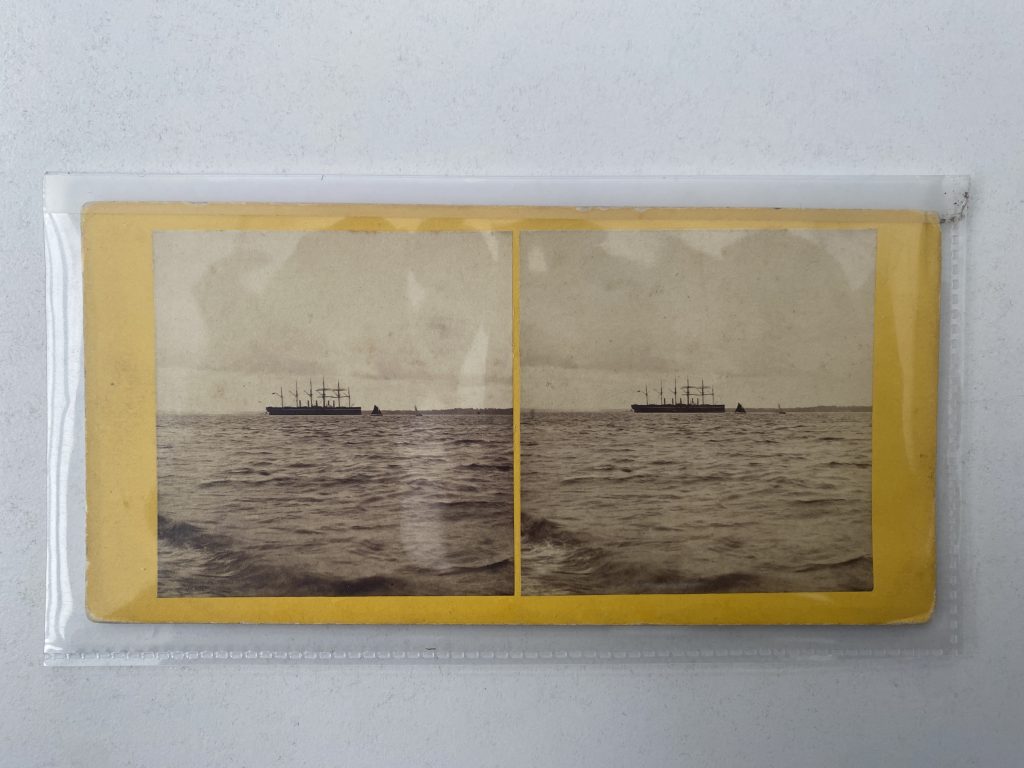This is a stereocard which carries an image of I.K. Brunel’s SS Great Eastern, likely taken on or around 17 June 1860, as the ship set sail on her maiden transatlantic voyage. The photographer is anonymous, though the image resembles another of the same scene by George Washington Wilson. On the back of the card is the legend ‘The “Great Eastern” in Southampton Water (Instantaneous) No. 218’. In addition to documenting a feat of nineteenth-century shipbuilding designed by I.K. Brunel, the card itself is a witness to nineteenth-century popular entertainment, while the photographs are testament to rapid, and conjoined, nineteenth-century developments in science and art.
Stereocards are designed to be viewed using a handheld viewer which superposes two almost identical images positioned at roughly the same distance as the human eyes are from one another, to produce a single, more ‘lifelike’, and almost three-dimensional image. Such viewers, which became extremely popular, were designed for domestic entertainment, allowing Victorian consumers the opportunity to ‘experience’ a vast range of scenes from across the world without leaving their home. Oliver Wendell Holmes, who invented a new, lightweight viewer for the cards, wrote in 1859 that:
The first effect of looking at a good photograph through the stereoscope is a surprise such as no painting ever produced. The mind feels its way into the very depths of the picture. The scraggy branches of a tree in the foreground run out as if they would scratch our eyes out. The elbow of a figure stands forth so as to make us almost uncomfortable. Then there is such a frightful amount of detail, that we have the same sense of infinite complexity which Nature gives us. A painter shows us masses; the stereoscopic figure spares us nothing…
Many show engineering marvels such as the SS Great Eastern. All the same, they were not universally applauded; Charles Baudelaire by contrast wrote of ‘thousands of greedy eyes pressed against the holes of a stereoscope as though staring through the windows of eternity’ and suggested that not only ‘children coming home from school indulged in these stupidities’, but that ‘they infatuated the masses’.
The photographs on this card are themselves also representative of a crucial moment in the development of photography and photographic processes. They were almost certainly produced with a dual-lens stereo camera using wet collodion plates, a process which required significant expertise to handle successfully outside a studio, involving the use of a number of chemicals in the field. So-called ‘instantaneous’ photographs such as those seen here, made en plein air of a moving subject, could not have been achieved much before 1860, as they required chemical processes fast enough to permit very short exposure times. In chronological terms, this photograph was produced part-way between the pioneering experimentation of Joseph Nicéphore Niépce and Louis Daguerre in the 1820-30s, and Eadweard Muybridge’s photographic motion studies of the late 1870s. It also speaks to wider ‘competition’ in the 1850s amongst photographic pioneers seeking to be the first to ‘freeze’ the motion of water. This photograph of the Great Eastern is thus of a very different kind to the famous images of the ship before it launched, done by Robert Howlett, which are more ‘posed’ and static, and is emblematic of the rapid development of photographic processes in this period.

